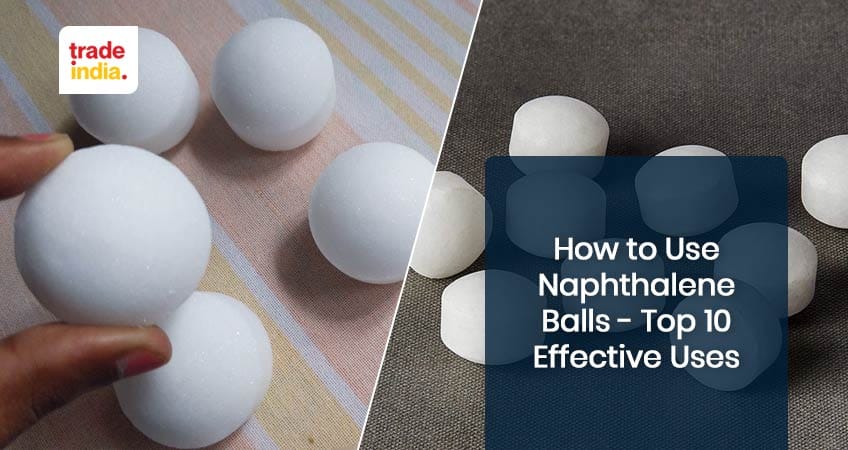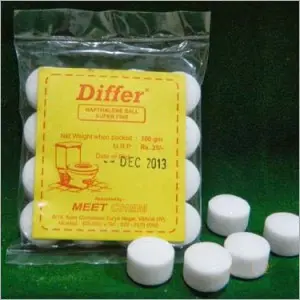Top 10 Effective Uses of Naphthalene Balls - 2024

For keeping items that could be damaged by mold or moth larvae, such as clothing, naphthalene ball (which are little balls of chemical insecticide and deodorant) are sometimes employed.
Naphthalene was once the primary component of mothballs, but due to its flammability, 1,4-dichlorobenzene has replaced it in many modern mothball formulations. Although both substances have the same flammability rating according to NFPA 704, the latter formulation may be slightly less flammable.
The latter substance is more difficult to recognize unless the shopper is familiar with its many other names, including para-dichlorobenzene, p-dichlorobenzene, pDCB, and PDB.
Naphthalene ball have a distinctively strong, pungent, sickly-sweet stench, and both of these versions share that characteristic. Sublimation occurs in both naphthalene and 1,4-dichlorobenzene, which results in a gas that is poisonous to moths and moth larvae.
Top 10 Effective Uses of Naphthalene Balls
Naphthalene comes from the distillation of coal tar in the petroleum industry. It is a key component in the production of phthalic anhydride. It's also included in certain moth repellents. It is the simplest hydrocarbon and the simplest organic compound.
Below, we'll go over some of naphthalene's most common applications:
Rinsing Woolens for Storage
Using mothballs to protect wool from pests is a no-brainer. Dissolve some Naphthalene ball in the last rinse water when you wash your sweaters before putting them away for the winter.
Using Naphthalene balls to protect wool from pests is a no-brainer. Dissolve some mothballs in the last rinse water when you wash your sweaters before putting them away for the winter.
However, moths are less likely to seek out clothing as a food source as synthetic fabrics like nylon, polyethylene, and polyester replace natural fibers like cotton, wool, and silk. Moths and their larvae are harmless because they do not consume man-made items.
Last but not least, Naphthalene balls are no longer as efficient as alternative home pest control measures, so moths and other pests are removed before they ever get to your clothes storage areas.
Removing bugs on potted plants
In order to get rid of the pests infesting your potted plants, place them in a sealed plastic bag for a week along with some Naphthalene balls provided by naphthalene ball manufacturers and some clear plastic baggies used for cleaning. Take your plant straight from the bag; it will be free of pests. It also has the added benefit of temporarily deterring moths.
The mothballs will decompose and produce toxic fumes as the plant is watered. These gas emissions are a double-edged sword since they pollute the air and the ground.
Cedar chips are superior to Naphthalene balls because they deter pest insects without introducing harmful chemicals to the soil. Avoid worrying about your pets ingesting dangerous chemicals or your plants taking them in through their roots.
Keeping mice out of your storage shed or garage
Never provide a mouse-proof garage for its winter stay. The mice will leave if you scatter Naphthalene balls around the garage. Place mothballs at the bottom of your potted plants to deter rodents from entering your potting shed.
Preventing pets like cats and dogs from ruining your Garden
Keep your old mothballs around. Spread them throughout your flower beds and gardens to deter cats, dogs, and rats. In other words, the fragrance is offensive to animals.
Naphthalene balls packaging often instructs consumers to store mothballs in an airtight container to contain the pesticide fumes and keep them out of the reach of people and pets. Clothes moths are killed by the accumulated gases emitted by mothballs when stored in sealed containers.
Many people make the mistake of storing mothballs in containers that don't seal properly, releasing the poisonous vapors into the room. This can result in chronic exposure, which has the potential to harm one's health.
Mothballs are often inappropriately used to repel insects, snakes, and other wildlife from gardens and other outdoor spaces. When used in the yard, mothballs can cause serious health problems for people, animals, and pets. When utilized in the yard, Naphthalene balls pose a threat to the environment. Use of mothballs correctly and possible alternatives to using mothballs are discussed further down the page.
Repelling the nighttime pests
Spreading some naphthalene balls uses around the attic or belfry will deter an invasion of bats. In order to keep silverfish away from the boxes you have stored in the attic, sprinkle some mothballs inside.
Use in Fumigant
The fumigant naphthalene has been employed. It used to be the main component of mothballs, but now more environmentally friendly options like 1,4-dichlorobenzene are used instead. To prevent the development of adult and larval stages of many textile-feeding moths, naphthalene pellets should be stored in an airtight container.
The soil can be treated with naphthalene balls as a fumigant insecticide, the attic can be fumigated to keep out pests like opossums, and museum storage drawers and cabinets can be fumigated to keep out insect pests.
Derivative uses
One of the most common applications for naphthalene balls is in the manufacturing of phthalic anhydride, an intermediary in the production of plasticizers for polyvinyl chloride and alkyd resin polymers, which are then used in the creation of paints and varnishes.
There are a lot of useful naphthalenesulfonic acids and sulfonates. Many dyestuffs, pigments, rubber processing chemicals, and other compounds and pharmaceuticals can be synthesized from naphthalenesulfonic acid.
Synthetic and natural rubbers, agricultural herbicides, colors, and lead-acid battery plates all employ them as dispersants. CFT and other medicinal salts are formed from naphthalenedisulfonic acids like Armstrong's acid.
Solvent uses
The solubilizing properties of molten naphthalene make it a useful medium for dissolving aromatic chemicals that are otherwise difficult to dissolve. It's more effective than many other high-boiling solvents, including dichlorobenzene, benzonitrile, nitrobenzene, and durene.
The 1:1 Diels-Alder adduct is easily obtained by performing the reaction of C60 with anthracene in refluxing naphthalene. A DDQ-in-naphthalene solution has been used to successfully aromatize hydroporphyrins.
Dye Making
In large quantities, naphthalene is used to create azo colors. Naphthoxyacetic acids are a useful agrichemical. Even, there are multiple naphthalene balls side effects like vomiting, eye irritation, abdominal cramps and diarrhea.
Hydrogenation of naphthalene produces the low-volatility decahydronaphthalene (decalin) or solvents tetrahydronaphthalene (tetralin). In this case, tetralin serves as the hydrogen donor solvent.
Inks can benefit from a mixture of diisopropylnaphthalenes, which are produced when naphthalene is alkylated with propylene.
Several medications, such the beta blocker propranolol and the nonsteroidal anti-inflammatory drug nabumetone, are derived from substituted napthalenes.
Other Uses
Because of its high volatility, naphthalene balls price can be used for a range of applications, such as the engineering study of heat transfer by mass sublimation, the fabrication of high-porosity grinding wheels, and even as a sublimable propellant for cold gas satellite rockets.
As a result, there is no comparison between traditional chemical mothballs and the newer "natural" alternatives. The one kills, while the other tries to repel, therefore it's not surprising that their ingredients and functions are different.
If you have a moth problem or just want to make sure you never have, mothballs are a great option because they are highly effective at attracting and killing moths while leaving your closet odor-free.
The decline of mothballs as the last line of defense in your closet may be the concluding act in the fascinating saga of this odiferous and ephemeral chemical. Looking back over the development of mothballs tells us one thing for sure: taking care of your clothes is important, and scientists will keep coming up with new ways to maintain your wardrobe.
FAQs: Naphthalene Balls
Q: What types of insects do naphthalene balls repel?
Naphthalene balls repel Squirrel, Bats, Mouse, Snakes, Beetles, Bees, Fly, Mosquito, Ladybugs, Mantis, Phasmids, Dragonfly, Butterflies, Lepioptera, etc.
Q: How do I use naphthalene balls?
Mothballs, along with the clothing or other goods, should be stored in airtight containers. If you seal the container, the fumes will prevent the moths from escaping. When the chemicals are contained in airtight containers, they won't be able to disperse throughout the home. Go for stackable plastic bins and garment bags that can be zipped shut and stashed away in the attic or beneath the bed. Using an adequate quantity of mothballs can help prevent damage from clothing moths, but only if the moths are sufficiently discouraged. You can prevent moths from eating your clothes by simply laying mothballs on or near them.
Q: Are naphthalene balls safe to use around children and pets?
Mothballs contain substances that are harmful to both people and animals. If the dog's red blood cells are severely damaged by naphthalene exposure (a process known as haemolysis), the dog will develop anemia. Damage to the kidneys is a possible side effect of the breakdown of red blood cells. Naphthalene, the active ingredient in mothballs and other goods, is a solid that decomposes into a poisonous gas. Insects will die from the noxious vapor, and it may even deter animals.
Q: What types of retailers typically sell naphthalene balls?
Here are some best naphthalene ball retailers at Trade India
- Housing Galaxy
- Alok Industries
- Kavit Polybind
- M/S Paras Chemicals
Related Blog Topics:


